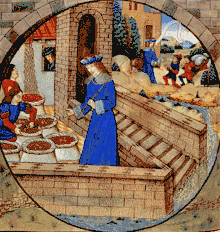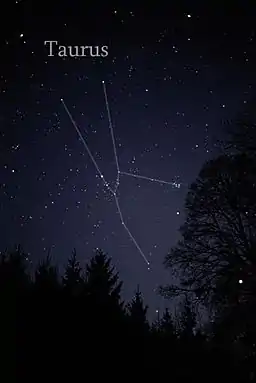Bull of Heaven
In ancient Mesopotamian mythology, the Bull of Heaven is a mythical beast fought by the hero Gilgamesh. The story of the Bull of Heaven has two different versions: one recorded in an earlier Sumerian poem and a later version in the standard Akkadian Epic of Gilgamesh. In the Sumerian poem, the Bull is sent to attack Gilgamesh by the goddess Inanna for reasons that are unclear. The more complete Akkadian account comes from Tablet VI of the Epic of Gilgamesh, in which Gilgamesh rejects the sexual advances of the goddess Ishtar, the East Semitic equivalent of Inanna, leading the enraged Ishtar to demand her father Anu for the Bull of Heaven, so that she may send it to attack Gilgamesh in Uruk. Anu gives her the Bull and she sends it to attack Gilgamesh and his companion, the hero Enkidu, who slay the Bull together.

After defeating the Bull, Enkidu hurls the Bull's right thigh at Ishtar, taunting her. The slaying of the Bull results in the gods condemning Enkidu to death, an event which catalyzes Gilgamesh's fear for his own death, which drives the remaining portion of the epic. The Bull was identified with the constellation Taurus and the myth of its slaying may have held astronomical significance to the ancient Mesopotamians. Aspects of the story have been compared to later tales from the ancient Near East, including legends from Ugarit, the tale of Joseph in the Book of Genesis, and parts of the ancient Greek epics, the Iliad and the Odyssey.
Mythology
Gilgamesh and the Bull of Heaven
In the Sumerian poem Gilgamesh and the Bull of Heaven, Gilgamesh and Enkidu slay the Bull of Heaven, who has been sent to attack them by the goddess Inanna, the Sumerian equivalent of Ishtar.[4][5][6] The plot of this poem differs substantially from the corresponding scene in the later Akkadian Epic of Gilgamesh.[7] In the Sumerian poem, Inanna does not seem to ask Gilgamesh to become her consort as she does in the later Akkadian epic.[5] Furthermore, while she is coercing her father An to give her the Bull of Heaven, rather than threatening to raise the dead to eat the living as she does in the later epic, she merely threatens to let out a "cry" that will reach the earth.[7]
Epic of Gilgamesh
In Tablet VI of the standard Akkadian Epic of Gilgamesh, after Gilgamesh rebuffs her sexual advances, Ishtar goes to Heaven, where she complains to her mother Antu and her father Anu.[8] She demands that Anu give her the Bull of Heaven[9][10][11] and threatens that, if he refuses, she will smash the gates of the Underworld and raise the dead to eat the living.[12][11] Anu at first objects to Ishtar's demand, insisting that the Bull of Heaven is so destructive that its release would result in seven years of famine.[12][10] Ishtar declares that she has stored up enough grain for all people and all animals for the next seven years.[12][10] Eventually, Anu reluctantly agrees to give it to Ishtar, whereupon she unleashes it on the world, causing mass destruction.[9][12]
The Bull's first breath blows a hole in the ground that one hundred men fall into and its second breath creates another hole, trapping two hundred more.[12][11] Gilgamesh and Enkidu work together to slay the Bull;[9][12][13] Enkidu goes behind the Bull and pulls its tail[12] while Gilgamesh thrusts his sword into the Bull's neck, killing it.[12] Gilgamesh and Enkidu offer the Bull's heart to the sun-god Shamash.[14][15] While Gilgamesh and Enkidu are resting, Ishtar stands up on the walls of Uruk and curses Gilgamesh.[14][16][17] Enkidu tears off the Bull's right thigh and throws it in Ishtar's face.[14][16][17][10]
Ishtar calls together "the crimped courtesans, prostitutes and harlots"[14] and orders them to mourn for the Bull of Heaven.[14][16] Meanwhile, Gilgamesh holds a celebration over the Bull of Heaven's defeat.[18][16] Tablet VII begins with Enkidu recounting a dream in which he saw Anu, Ea, and Shamash declare that either Gilgamesh or Enkidu must die as punishment for having slain the Bull of Heaven.[2] They choose Enkidu, who soon grows sick,[2] and dies after having a dream of the Underworld.[2] Tablet VIII describes Gilgamesh's inconsolable grief over his friend's death[2][19] and the details of Enkidu's funeral.[2] Enkidu's death becomes the catalyst for Gilgamesh's fear of his own death, which is the focus of the remaining portion of the epic.[20][21]
Symbolism and representation
Numerous depictions of the slaying of the Bull of Heaven occur in extant works of ancient Mesopotamian art.[22][10] Representations are especially common on cylinder seals of the Akkadian Empire (c. 2334 – 2154 BC).[10] These show that the Bull was clearly envisioned as a bull of abnormally large size and ferocity.[11] It is unclear exactly what the Bull of Heaven represents, however.[11] Michael Rice speculates that the Bull may represent an earthquake, since bulls in general were widely associated with earthquakes in ancient cultures.[11] He also posits that the Bull may represent summertime, which was a period of drought and infertility for people in ancient Mesopotamia.[11] Assyriologists Jeremy Black and Anthony Green observe that the Bull of Heaven is identified with the constellation Taurus[9] and argue that the reason why Enkidu hurls the bull's thigh at Ishtar in the Epic of Gilgamesh after defeating it may be an effort to explain why the constellation seems to be missing its hind quarters.[9]
Rice also argues for an astronomical interpretation of the slaying of the Bull,[22] noting that the constellation Canis Major was sometimes iconographically represented in ancient Egyptian texts as a bull's thigh, though he notes that there is no evidence of this identification in Sumer.[22] He also observes that thigh was often used in ancient Near Eastern texts as a substitute for the genitals.[22] Gordon and Rendsburg note that the notion of flinging a bull's leg at someone "as a terrible insult" is attested across a wide geographic area of the ancient Near East[10] and that it recurs in the Odyssey, an ancient Greek epic poem.[10] Some scholars consider the Bull of Heaven to be the same figure as Gugalanna, the husband of Ereshkigal mentioned by Inanna in Inanna's Descent into the Underworld.[23]
Influence on later stories

Cyrus H. Gordon and Gary A. Rendsburg note that the Near Eastern motif of seven years of famine following the death of a hero is attested in the Ugaritic myth of the death of Aqhat[10] and that the theme of someone predicting seven years of famine in advance and storing up supplies is also found in the Hebrew story of Joseph from the Book of Genesis.[10] According to the German classical scholar Walter Burkert, the scene in which Ishtar comes before Anu to demand the Bull of Heaven after being rejected by Gilgamesh is directly paralleled by a scene from Book V of the Iliad.[8] In the Epic of Gilgamesh, Ishtar complains to her mother Antu, but is mildly rebuked by Anu.[8] In the scene from the Iliad, Aphrodite, the later Greek development of Ishtar, is wounded by the Greek hero Diomedes while trying to save her son Aeneas.[24] She flees to Mount Olympus, where she cries to her mother Dione, is mocked by her sister Athena, and is mildly rebuked by her father Zeus.[24] Not only is the narrative parallel significant,[24] but so is the fact that Dione's name is a feminization of Zeus's own, just as Antu is a feminine form of Anu.[24] Dione does not appear throughout the rest of the Iliad, in which Zeus's consort is instead the goddess Hera.[24] Burkert therefore concludes that Dione is clearly a calque of Antu.[24]
British classical scholar Graham Anderson notes that, in the Odyssey, Odysseus's men kill the sacred cattle of Helios and are condemned to death by the gods for this reason, much like Enkidu in the Epic of Gilgamesh.[25] M. L. West states that the similarities run deeper than the mere fact that, in both cases, the creatures slain are bovines exempt from natural death.[26] In both cases, the person or persons condemned to die are companions of the hero, whose death or deaths force the hero to continue his journey alone.[26] He also notes that, in both cases, the epic describes a discussion among the gods over whether or not the guilty party must die[26] and that Helios's threat to Zeus if he does not avenge the slaughter of his cattle in the Odyssey is very similar to Ishtar's threat to Anu when she is demanding the Bull in the Epic of Gilgamesh.[26] Bruce Louden compares Enkidu's taunting of Ishtar immediately after slaying the Bull of Heaven to Odysseus's taunt of the giant Polyphemus in Book IX of the Odyssey.[27] In both cases, the hero's own hubris after an apparent victory leads a deity to curse him.[27]
References
- Powell 2012, p. 342.
- Black & Green 1992, p. 90.
- Powell 2012, pp. 341–343.
- Black & Green 1992, p. 89.
- Tigay 2002, p. 24.
- ETCSL 1.8.1.2
- Tigay 2002, pp. 24–25.
- Burkert 2005, pp. 299–300.
- Black & Green 1992, p. 49.
- Gordon & Rendsburg 1997, p. 46.
- Rice 1998, p. 99.
- Jacobsen 1976, p. 201.
- Gordon, Rendsburg & 1лғомжто997, p. 46.
- Dalley 1989, p. 82.
- Fontenrose 1980, pp. 1 68–169.
- Fontenrose 1980, p. 169.
- Jacobsen 1976, p. 202.
- Dalley 1989, p. 82-83.
- Fontenrose 1980, p. 171.
- Gordon & Rendsburg 1997, pp. 46–47.
- Rice 1998, pp. 100–101.
- Rice 1998, p. 100.
- Pryke 2017, p. 205.
- Burkert 2005, p. 300.
- Anderson 2000, p. 127.
- West 1997, p. 417.
- Louden 2011, p. 194.
Bibliography
- Anderson, Graham (2000). Fairytale in the Ancient World. New York City, New York and London, England: Routledge. ISBN 978-0-415-23702-4.CS1 maint: ref=harv (link)
- Black, Jeremy; Green, Anthony (1992), Gods, Demons and Symbols of Ancient Mesopotamia: An Illustrated Dictionary, The British Museum Press, ISBN 978-0714117058CS1 maint: ref=harv (link)
- Burkert, Walter (2005), "Chapter Twenty: Near Eastern Connections", in Foley, John Miles (ed.), A Companion to Ancient Epic, New York City, New York and London, England: Blackwell Publishing, ISBN 978-1-4051-0524-8CS1 maint: ref=harv (link)
- Dalley, Stephanie (1989), Myths from Mesopotamia: Creation, the Flood, Gilgamesh, and Others, Oxford, England: Oxford University Press, ISBN 978-0-19-283589-5CS1 maint: ref=harv (link)
- Fontenrose, Joseph Eddy (1980) [1959], Python: A Study of Delphic Myth and Its Origins, Berkeley, California, Los Angeles, California, and London, England: The University of California Press, ISBN 978-0-520-04106-6CS1 maint: ref=harv (link)
- Gordon, Cyrus H.; Rendsburg, Gary A. (1997) [1953], The Bible and the Ancient Near East, New York City, New York and London, England: W. W. Norton & Company, ISBN 978-0-393-31689-6CS1 maint: ref=harv (link)
- Jacobsen, Thorkild (1976), The Treasures of Darkness: A History of Mesopotamian Religion, New Haven, Connecticut and London, England: Yale University Press, ISBN 978-0-300-02291-9CS1 maint: ref=harv (link)
- Louden, Bruce (2011), Homer's Odyssey and the Near East, Cambridge, England: Cambridge University Press, ISBN 978-0-521-76820-7CS1 maint: ref=harv (link)
- Powell, Barry B. (2012) [2004], "Gilgamesh: Heroic Myth", Classical Myth (Seventh ed.), London, England: Pearson, pp. 336–350, ISBN 978-0-205-17607-6CS1 maint: ref=harv (link)
- Pryke, Louise M. (2017), Ishtar, New York and London: Routledge, ISBN 978-1-138--86073-5CS1 maint: ref=harv (link)
- Rice, Michael (1998), The Power of the Bull, New York City, New York and London, England: Routledge, ISBN 978-0-415-09032-2CS1 maint: ref=harv (link)
- Tigay, Jeffrey H. (2002) [1982], The Evolution of the Gilgamesh Epic, Wauconda, Illinois: Bolchazzy-Carucci Publishers, Inc., ISBN 978-0-86516-546-5CS1 maint: ref=harv (link)
- West, M. L. (1997), The East Face of Helicon: West Asiatic Elements in Greek Poetry and Myth, Oxford, England: Clarendon Press, ISBN 978-0-19-815221-7CS1 maint: ref=harv (link)
